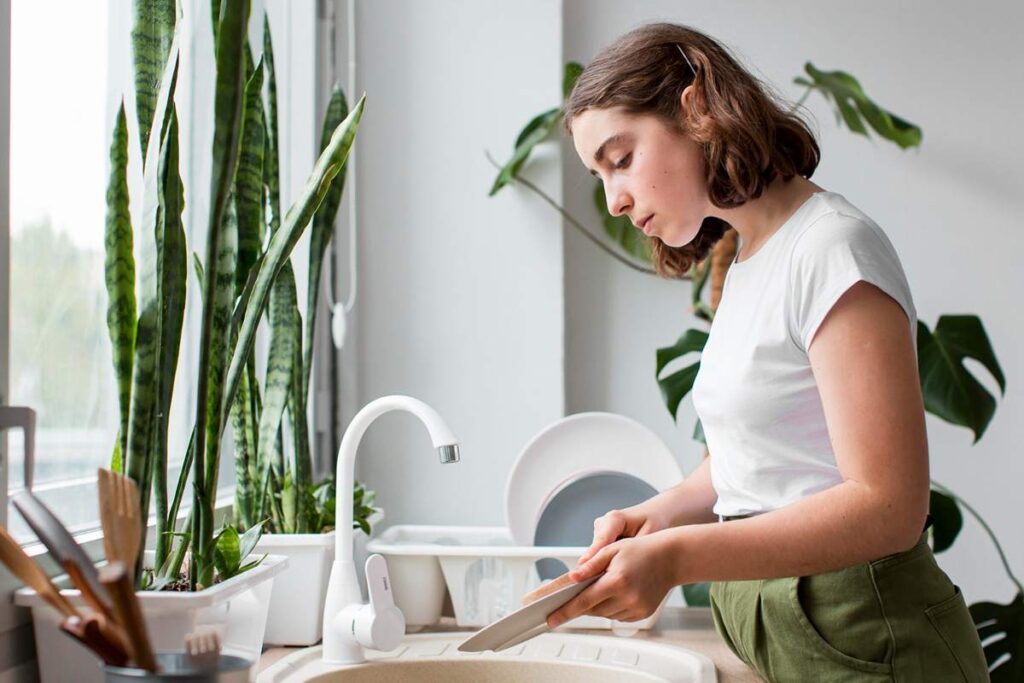Are tiny flying bugs coming out of your kitchen or bathroom sink? These are gnats—small, annoying insects that love dirty, wet places. They often show up in drains because of leftover food, moisture, and grime. If you’re wondering how to get rid of gnats in sink, don’t worry—you don’t need harsh chemicals or expensive sprays. In this guide, you’ll learn easy, safe, and permanent ways to remove gnats using simple things from your home. These methods work fast, protect your health, and stop the gnats from coming back. Let’s get your sink clean and gnat-free—for good!
Why Are There Gnats in My Sink?
You might be wondering why these tiny bugs keep flying around your sink. Gnats are not just annoying—they show up for a reason. Your sink provides the perfect place for them to live and grow. Here’s what attracts them and why they love your drain so much.
What Attracts Gnats to Sinks
Gnats are drawn to warm, damp, and dirty areas—especially places with leftover food or gunk.
Here’s what attracts them:
- Food scraps: Tiny bits of food left in the drain or on dishes.
- Dirty drains: Slime and grime inside pipes are like a feast for gnats.
- Standing water: Moist areas around the drain are perfect for gnats to lay eggs.
- Organic waste buildup: Old grease, soap scum, and other gunk in the drain feed them.
Are Sink Gnats Dangerous?
Gnats in the sink might not bite you, but they are still unhygienic and unpleasant.
Here’s why they can be a problem:
- While they don’t cause serious health issues, they can carry germs from the dirty drain to your kitchen or bathroom surfaces.
- Female gnats can lay dozens of eggs at once, making the problem bigger in just a few days.
- A small gnat issue can quickly turn into an infestation if not treated properly.
How to Get Rid of Gnats in Sink (Step-by-Step)

If you’re tired of dealing with gnats in your sink, don’t worry! There are simple and natural ways to get rid of them. These methods are safe, cost-effective, and easy to do using things you already have at home.
Clean Your Drain Thoroughly
The first step in getting rid of gnats is to clean your drain thoroughly. Gnats love to lay eggs in dirty, food-filled drains, so a deep clean will help eliminate them.
- Remove food waste: Clear out any food particles from your sink and drain. This prevents gnats from finding their food source.
- Use a drain brush or old toothbrush: Scrub inside the drain to remove any slime or gunk that’s stuck to the walls of the pipes. This makes the environment less inviting for gnats to live and breed.
Use Boiling Water
One of the simplest and most effective ways to get rid of gnats in your sink is to pour boiling water down the drain. It’s safe, cheap, and works fast.
- Pour boiling water down the drain twice a day: This will kill any gnat larvae or eggs hiding inside the pipes. It also helps clear out any food or waste buildup.
- Safe, cheap, and effective: Boiling water is a simple solution that doesn’t require any harsh chemicals, making it safe for your plumbing.
Try a Dish Soap Trap
If you’re still seeing gnats around your sink, a dish soap trap can help catch and kill them. This method works by attracting gnats to the soap mixture, which traps them inside.
- Mix dish soap with vinegar in a small bowl: The vinegar attracts gnats, while the dish soap traps them by breaking the surface tension.
- Leave near the sink overnight to trap gnats: Place the bowl near the sink overnight, and the gnats will be drawn in and trapped by the solution.
How to Get Rid of Gnats in Sink with Vinegar

Vinegar is an excellent, natural solution for getting rid of gnats in your sink. It works by killing gnat larvae and breaking down the buildup in the drain, which attracts gnats in the first place.
White Vinegar + Dish Soap + Warm Water
To make a powerful yet safe mixture that will help get rid of gnats, follow this easy recipe:
- White vinegar + dish soap + warm water: Mix 1 cup of white vinegar, 1 tablespoon of dish soap, and 2 cups of warm water in a bowl. The vinegar attracts gnats, the dish soap traps them, and the warm water helps loosen up any gunk or buildup in the drain.
Pour Down the Drain and Cover It for 30 Minutes
- Pour the mixture down the drain: Slowly pour the vinegar solution down the drain, making sure it covers the sides and reaches the pipe buildup.
- Cover it for 30 minutes: After pouring the solution, cover the drain with a damp cloth or towel. This traps the fumes and allows the vinegar mixture to work more effectively.
Kills Larvae and Removes Buildup
The vinegar solution works in two ways:
- Kills gnat larvae: The acidic properties of vinegar kill any larvae or eggs that are hiding in the drain.
- Removes buildup: The mixture helps break down any organic waste or grime inside the drain, which is a perfect breeding ground for gnats.
How to Get Rid of Gnats in Sink with Baking Soda
Baking soda is a powerful and natural ingredient that can help you get rid of gnats in your sink. When combined with vinegar and hot water, it creates a fizzing reaction that breaks down grime and kills gnats. This method is safe, simple, and works fast.
Baking Soda + Vinegar + Hot Water Method
This combination creates a fizzy, bubbling action that cleans your pipes, clears buildup, and kills gnats hiding inside your sink. Here’s how it works:
- Natural fizz reaction: The reaction between baking soda and vinegar loosens up any dirt or waste in your drain, while also killing gnat larvae.
- Clears grime and kills gnats: The bubbling action cleans the pipes, making it harder for gnats to thrive in your sink.
Step-by-Step Method
- Pour ½ cup of baking soda: First, pour ½ cup of baking soda directly into the drain. It will begin working immediately, absorbing moisture and odors.
- Add 1 cup of vinegar: After the baking soda, pour 1 cup of vinegar down the drain. The two ingredients will fizz and bubble, breaking down the grime that attracts gnats.
- Let sit for 15 minutes: Allow the baking soda and vinegar mixture to sit for 15 minutes. This gives the fizzing reaction time to work its magic.
- Flush with boiling water: Finally, pour boiling water down the drain to flush everything out. This will clear any leftover debris and make sure the pipes are clean.
How to Get Rid of Gnats in Sink Home Remedies

If you’re looking for natural and effective home remedies to get rid of gnats in your sink, you’ve come to the right place. These remedies use ingredients you probably already have at home and are perfect for keeping gnats away without harmful chemicals.
Lemon Juice (Natural Antibacterial)
Lemon juice is a powerful, natural antibacterial agent that can help cleanse your sink and get rid of gnats.
- Kills bacteria: The acidity in lemon juice not only kills harmful bacteria but also creates an environment that gnats dislike.
- Fresh scent: Lemon juice leaves a fresh, clean scent behind, which makes it a great choice for keeping your sink smelling good while also repelling gnats.
Salt + Baking Soda + Vinegar Combo
This classic combination is a natural and effective way to clean your sink and eliminate gnats.
- Salt: Salt helps to scrub the sink and pipes, removing grime and buildup that attract gnats.
- Baking soda: The fizzing action of baking soda combined with vinegar helps break down gunk and kills gnat larvae.
- Vinegar: Vinegar disinfects and removes any organic waste, creating a less hospitable environment for gnats.
Essential Oils Like Peppermint or Tea Tree (Gnats Hate These!)
Gnats dislike strong-smelling essential oils, which makes peppermint and tea tree oil perfect for repelling them.
- Peppermint oil: The strong scent of peppermint oil is a natural insect repellent. Simply add a few drops of peppermint essential oil to a bowl of water and place it near your sink.
- Tea tree oil: Tea tree oil also works as a natural insect repellent, and it has antimicrobial properties that can help keep your sink clean.
DIY Gnat Spray (Water + Essential Oil) for Surface Cleaning
Make your own DIY gnat repellent spray to clean the sink surfaces and keep gnats at bay.
- Water + essential oil: Mix 1 cup of water with 10–15 drops of essential oil (peppermint, tea tree, or eucalyptus) in a spray bottle.
- Spray surfaces: Spray this mixture on the sink and surrounding areas. The scent will repel gnats and keep your sink smelling fresh.
How to Get Rid of Drain Gnats Permanently

Getting rid of gnats in your sink for good requires consistent effort and smart habits to prevent their return. Here are a few strategies that will help you eliminate gnats permanently.
Regular Cleaning Routine
Establishing a regular cleaning routine is key to keeping gnats away and maintaining a gnat-free sink.
Weekly Vinegar Flush: Every week, flush your drain with a mixture of vinegar and warm water. This helps to clear out any waste buildup that attracts gnats and prevents larvae from thriving. Pour one cup of vinegar down the drain and let it sit for about 30 minutes before rinsing with hot water.
Avoid Food Buildup in Sink: One of the biggest attractants for gnats is food debris. Always clean your dishes right away, wipe down surfaces, and ensure no food scraps are left in the sink. Consider using a garbage disposal for any food waste.
Keep Drain Dry at Night: Moisture is a major factor in attracting gnats. After cleaning, try to keep the drain dry at night. You can do this by wiping the sink and leaving it to air dry or using a dry cloth to absorb any excess moisture.
Install a Drain Cover or Mesh
A practical way to prevent gnats from entering the sink is by installing a drain cover or mesh.
Prevent Gnats from Entering: A drain cover or mesh can act as a barrier, preventing gnats from flying into the drain. These simple tools are effective at stopping gnats from laying eggs in the pipes.
Stops Food Debris from Going In: A mesh cover also prevents food debris from entering the drain. This reduces the chances of organic waste building up inside the pipes, which attracts gnats in the first place.
What Most People Get Wrong About Sink Gnats
While dealing with gnats in your sink, many people make common mistakes that hinder their efforts to eliminate these pests completely. Understanding the right approach is key to ensuring long-term success. Here’s what most people get wrong about sink gnats and how to fix it.
Only Killing Flying Gnats Isn’t Enough—Clean the Drain to Stop Eggs
One of the biggest mistakes people make is focusing only on killing the gnats they see flying around. While this may reduce the number of gnats temporarily, it won’t solve the root of the problem. Gnats lay eggs inside the drain, and unless you clean the drain thoroughly, those eggs will hatch and create a new generation of gnats.
Focus on the source: A clean drain ensures that gnats can’t breed and helps you avoid another infestation.
Deep cleaning: Regular cleaning with natural ingredients like vinegar or baking soda helps prevent larvae from hatching.
Overusing Chemicals Can Damage Pipes or Health—Natural Is Safer
Many people turn to harsh chemicals to get rid of gnats, but this approach can cause more harm than good. Overusing chemical drain cleaners can damage your pipes, leading to leaks and expensive repairs. Additionally, chemicals can harm your health by releasing harmful fumes or coming into contact with your skin.
Safer alternatives: Natural methods like vinegar, baking soda, and essential oils are not only effective at eliminating gnats but are also safe for your pipes and health.
Eco-friendly solutions: Using natural ingredients helps protect the environment and ensures your home remains safe.
Drain Gnats Are Often Misidentified as Fruit Flies
Another common mistake is misidentifying the pests in your sink. Many people mistake drain gnats for fruit flies. While they might look similar, they have different habits and causes.
Drain gnats: These pests are attracted to organic waste and moisture in drains, where they lay eggs. They tend to be smaller and are often seen around sink areas or drains.
Fruit flies: These are attracted to ripe fruits or vegetables, and are usually seen near food sources.
When to Call a Professional
While DIY methods can be effective in many cases, there are situations where calling a professional is the best solution. If you’ve tried multiple methods and the gnats keep returning, it may be time to seek expert help. Here are a few signs it’s time to call in a professional:
Infestation Keeps Returning
If you notice that gnats are repeatedly infesting your sink, despite cleaning efforts and DIY treatments, it could indicate a deeper issue. Continuous infestations may suggest that the gnats are breeding in hidden areas of your plumbing or drain system.
- Persistent problem: Even after thorough cleaning, if gnats continue to appear, a professional can help identify the source and stop the cycle.
Found in Multiple Drains
When gnats aren’t just confined to one drain but appear in multiple drains throughout your home, it’s a sign that the problem may be widespread. This is more than a simple nuisance—it could mean that there’s an issue within the plumbing system itself.
- Widespread issue: A professional plumber or pest control expert will have the tools and expertise to treat multiple drains and prevent future infestations.
DIY Methods Don’t Work After a Week
If you’ve tried several home remedies and DIY treatments, such as using vinegar, baking soda, or essential oils, and haven’t seen any improvement within a week, it may be time to call in a professional. Gnats can multiply quickly, and if DIY methods haven’t worked, it could be a sign that you need a more thorough, long-lasting solution.
- No improvement: When your efforts don’t yield results, a professional pest control service can provide more powerful treatments and a tailored plan to ensure permanent removal.
Tips to Keep Your Sink Gnat-Free

Preventing gnats from invading your sink is all about maintaining cleanliness and being proactive. Here are some simple yet effective tips to ensure your sink stays gnat-free:
Dry the Sink Every Night
Moisture is a major attractant for gnats, so it’s important to dry the sink every night. After using the sink, take a moment to wipe it down and remove any standing water. This small habit will prevent gnats from finding a suitable environment to breed.
- Keep the sink dry: Gnats are drawn to damp surfaces, so eliminating moisture makes it less inviting for them.
Use Garbage Disposal Correctly
If your sink has a garbage disposal, make sure you’re using it correctly. Don’t let food scraps linger in the disposal or around the sink. After using the garbage disposal, run hot water for a few seconds to flush out any leftover debris that could attract gnats.
- Regularly clean the disposal: A clean disposal is essential for preventing gnats. Run a mixture of ice cubes and salt through it once a week to keep it fresh.
Throw Away Old Fruit and Veggies
Gnats love decaying organic matter, especially old fruit and vegetables. Regularly check your kitchen for any produce that’s past its prime and throw it away. Store fresh fruit and veggies in the fridge to prevent attracting gnats.
- Keep food fresh: Regularly clean your countertops and dispose of overripe or rotting food to keep gnats away.
Clean Sponge Holders and Sink Edges
Sponge holders and the edges of your sink are often overlooked but can harbor moisture and organic material. Make sure to clean these areas regularly to prevent them from becoming breeding grounds for gnats.
- Keep the sink area clean: Wipe down the edges and holders daily, ensuring there’s no buildup of food or moisture.
FAQs
How do you get rid of gnats in your sink drain?
To get rid of gnats in your sink drain, clean the drain thoroughly using a drain brush, boiling water, and natural remedies like vinegar or baking soda. This will eliminate gnats and remove the organic buildup they feed on.
What is the fastest way to get rid of gnats?
The fastest way to get rid of gnats is by using boiling water, pouring it down your drain twice a day, or setting up a vinegar trap near the sink. These methods quickly kill larvae and eliminate adult gnats.
Will bleach kill gnats in the drain?
Bleach can kill gnats in the drain, but it’s not recommended due to its harsh nature, which can damage pipes and harm your health. Instead, use natural alternatives like vinegar or baking soda for safer results.
What smell do gnats hate?
Gnats hate the strong smells of essential oils such as peppermint, lavender, and tea tree oil. These scents can repel gnats and help keep them away from your sink area.
How do I prevent gnats from coming back?
To prevent gnats from coming back, make sure to dry your sink every night, clean the drain regularly, and dispose of food waste properly. Keeping your sink area clean and dry will stop gnats from finding a breeding ground.
Can I use essential oils to kill gnats in my sink?
Yes, essential oils like peppermint and tea tree oil can be used to repel gnats and clean surfaces. Adding a few drops to vinegar or water creates an effective, natural gnat repellent.
Are drain flies the same as gnats?
No, drain flies and gnats are different. Drain flies breed in moist areas like drains, while gnats are typically attracted to decaying organic matter. Both can infest your sink, but the treatments for each may vary slightly.
Conclusion
In conclusion, getting rid of gnats in your sink doesn’t have to be a difficult or expensive task. By using safe and natural methods, you can quickly eliminate these pests without harming your health or your pipes. Remember, effective solutions include cleaning your drain thoroughly, using simple ingredients like vinegar, baking soda, and essential oils, and maintaining a dry, clean sink.
These steps are not only natural and safe, but they also work fast to keep your kitchen gnat-free. Regular cleaning, such as drying your sink every night and disposing of food scraps properly, will go a long way in preventing future infestations.










